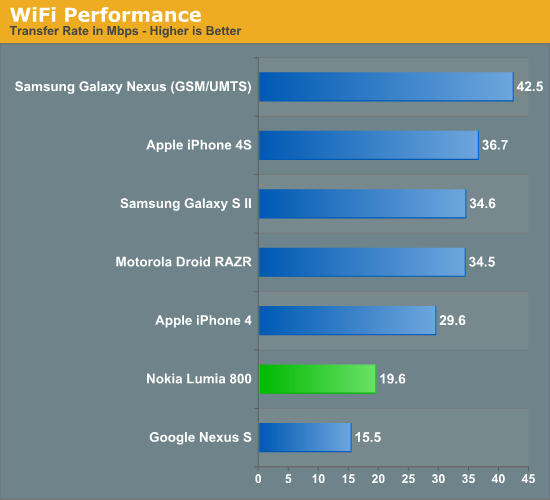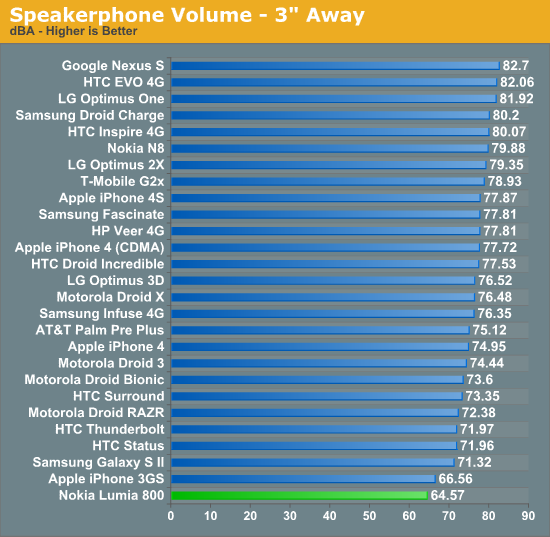Nokia Lumia 800 Review - Nokia's Brave New Foray into WP7
by Brian Klug on January 4, 2012 7:00 AM EST- Posted in
- Smartphones
- Nokia
- windows phone 7
- Mobile
- WP7
- Lumia
- Lumia 800
Cellular
Cellular on the Lumia 800 is supplied courtesy the MSM8255’s onboard baseband. Like all the Qualcomm S2 parts, this means GSM/EDGE/WCDMA with HSPA+. The Lumia 800 also takes a microSIM as noted earlier, and I tested on AT&T in my market. There are actually two Lumia 800 variants, each with different WCDMA bands - we were sampled the European variant which worked with AT&T’s PCS 1900 MHz WCDMA in my market. The Nokia Lumia 800 Specifications page is a bit misleading since it would have you believe that there’s only one variant with quad-band WCDMA when there are actually two different tri-band WCDMA devices.
| Nokia Lumia 800 - Network Support | |
| GSM/EDGE Support | 850 / 900 / 1800 / 1900 MHz |
| RM-801 (Europe) WCDMA Support | 900 / 1900 / 2100 MHz |
| RM-819 (USA) WCDMA Support | 850 / 1900 / 2100 MHz |
| Baseband Hardware | QCT MDM8255 w/QTR8200 |
| HSPA Speeds | HSDPA 14.4 (Cat.10) / HSUPA 5.76 (Cat.6) |
I couldn’t do my usual stats collection and histogram on the Lumia 800 since there’s no way to export that data from any of the speed test applications on Windows Phone. However, I did run some tests and see acceptable levels of throughput out of the device.
.jpg)
.jpg)
Some speedtests taken with BandWidth on WP7
WiFi
WiFi and Bluetooth 2.1 EDR on the Lumia 800 is supplied courtesy of a Broadcom BCM4329 combo chip which we’ve seen numerous times before in a number of different smartphones. Though newer devices are starting to ship BCM4330, I wager that WP7.5 includes drivers for just BCM4329 (which a huge majority of Windows Phones include) and BCM4325 (Venue Pro). On the Lumia 800, this means single spatial stream 802.11b/g/n connectivity only on the 2.4 GHz band.

Regardless, WiFi range on the Lumia 800 is totally par for the current generation of devices. In addition, WP7.5 continues to do a great job at deciding when to hand off and back onto WiFi when leaving the coverage radius of your house. It’s the small things like these that (to me at least) really demarcate the previous generation of smartphone OSes from the new breed. Unfortunately, in our throughput test which consists of loading a 100 MB PDF hosted locally on an 802.11n network, the Lumia 800 isn’t quite up to the speed of other BCM4329 devices. I’d wager this has more to do with the OS than anything else, though running network throughput applications on the Lumia 800 also gave a similar number to our normal PDF download test.
I should also note that WP7.5 also includes the ability to connect to WiFi APs that don’t broadcast their SSID. There’s a tab under Advanced in WiFi that now allows you to enter all that information and connect away, this wasn’t possible until Mango.
Speakerphone
In calls, the speakerphone on the Lumia 800 is honestly a bit too quiet, and our testing with a sound level data logger backs this up. Even at absolute maximum (where we test, of course) I found the sound level inadequate while using Nokia Drive or placing calls. It isn’t so much the position of the speaker at the bottom that’s a problem (in fact this is a good place to locate it), it’s just not loud enough.

Hopefully, this can be addressed with some software tweaking of the gains for speakerphone volume.
I also recorded some call quality test samples on the Lumia 800. The smartphone also does have the multiple microphone system for common mode noise rejection, though I'm not certain whose IP is being leveraged - perhaps Qualcomm's Fluence?
Noise rejection on the Lumia 800 is very good at all but the most extreme volume levels. Still, there are handsets that can completely reject the ambient noise that you hear at our maximum volume level. Unless you're in an absurdly loud environment, chances are the Lumia 800 will do a good job rejecting noise common between the two microphone system.
GPS
The Lumia 800 uses the GPS/GLONASS (GNSS) system onboard MSM8255 which we’ve seen numerous times before. Though WP7 doesn’t have API access to NMEA data so we can see SNR from individual satellites, the Lumia 800 does seem to get a GPS lock speedily enough even in some tough environments. In both the maps application and Nokia Drive I had no issues getting a GPS lock in under a 5 seconds keeping the lock for the duration of navigation.










120 Comments
View All Comments
doubledeej - Thursday, January 5, 2012 - link
But Android customer satisfaction is horrible. Consumers might think they want it, but they change their mind after they've used it.WP7 has the highest customer satisfaction right now.
crispbp04 - Thursday, January 5, 2012 - link
You're too stupid to see the context of my comment, albeit I should have put a semi-colon instead of a period after "the minority of consumers want android". Read the next sentence. Dipshit. Only technogeek nerds WANT Android.Nataku - Thursday, January 5, 2012 - link
its ok, let the fanboys struggle with that os, my sis switched to lumia 800 because she's fed up with the two android phone she hadnote on consumer (that aren't geeks like us) purchases, they either listen to a friend or get pushed around by the sale people, the rest is marketting (eg. iphone) so no such thing as "every one wants android" crap...
solipsism - Wednesday, January 4, 2012 - link
So your idea of saving Nokia is to make every Nokia phone run Android so it has to compete with every other OEM using Android and has an ecosystem that appeals to only cheap, profitless devices or geeks, instead of going after the profitable markets by creating a quality and unique experience Nokia can control.WP7 is their best chance for survival. It's late to the game but WP7 is a brilliant OS, the second best mobile OS and development platform on the market today after iOS/Xcode.
As David Pogue said, It's only downfall is that "it's not popular because it's not popular." Another year could change all that and both Nokia and MS have the money and talent to hold on for many years looking for their opportunity.
Death666Angel - Wednesday, January 4, 2012 - link
Seems to me that most WP7 phones ship for a lot less money than Android hardware does. So I don't know why the margins would be so small. As fas as I know, WP7 also costs licensing whereas Android is free (in theory, MS still gets money for it from some manufacturers).Use whatever floats your boat, but don't think any one of them is superior in their own right. They are not.
davepermen - Wednesday, January 11, 2012 - link
If this would have been what consumers wanted, why was nokia going down so hard?Exactly
He saves their asses right now. Those N9 fans are loud on internet geek forums and discussions. They are not enough to make them survive, though.
WP7 is a very geeky os, one that you could love if you moved beyond "omg they changed their plans to survive they're SO uncool".
and i'm glad they did NOT went the android route. if you want android, there are already enough options. They need to have something that differenciates them from the masses, without the actual investement into building something on their own that is different.
465thGTG - Wednesday, January 4, 2012 - link
Hmm... as a long time iOS and Android user I find WP7 very fun and interesting. To each his own I guess.davepermen - Wednesday, January 11, 2012 - link
WP7 is an interesting os by itself, too. And yes, alive, unlike the N9.abhicherath - Wednesday, January 4, 2012 - link
this is really,really pretty....The N9 was rather prettier though.BTW could anybody tell me why exactly did elop ditch meego.It was functional,zippy and i would take it over mango given the choice...the only thing it lacked was a good ecosystem,ah well..
R.I.P MeeGo.
465thGTG - Wednesday, January 4, 2012 - link
Turns out ecosystems aren't easy to come by.